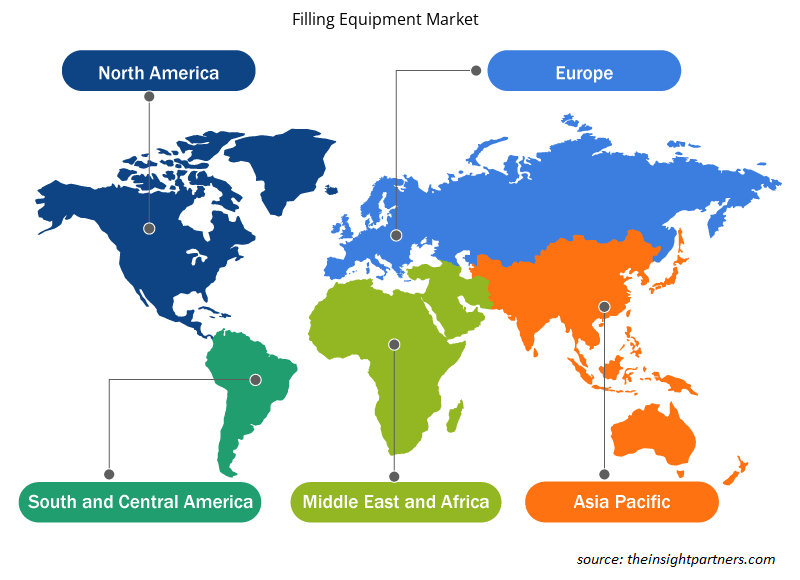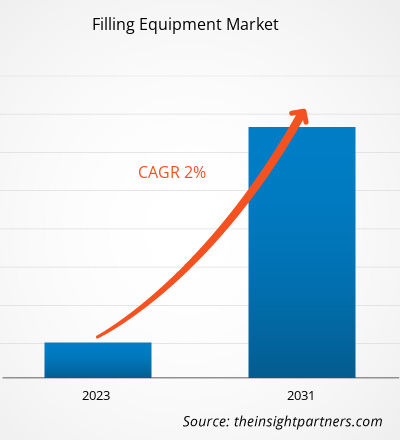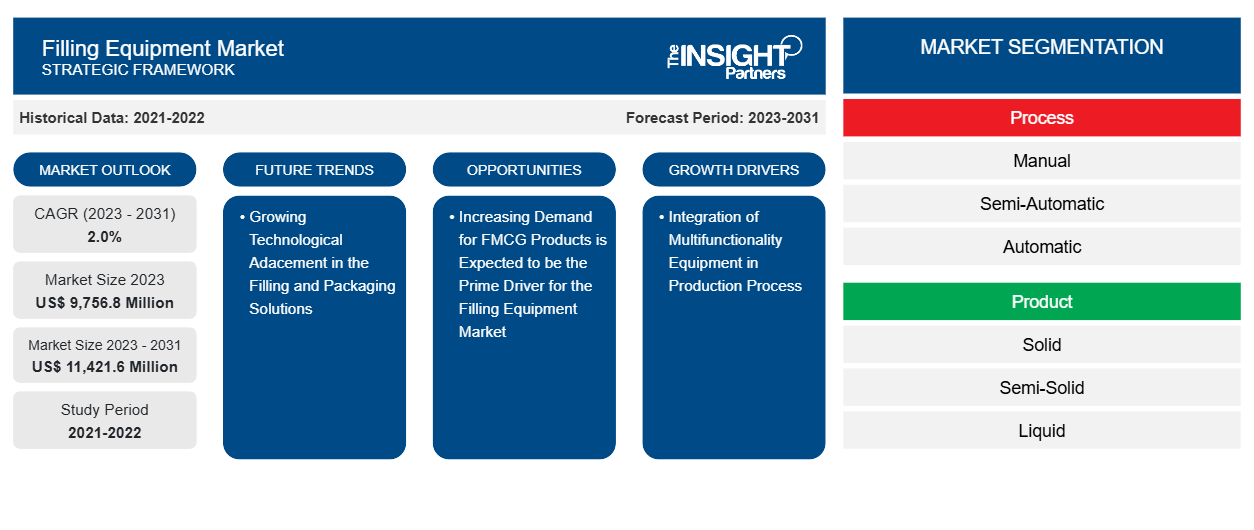预计到 2031 年,灌装设备市场规模将从 2023 年的 97.568 亿美元增至 114.216 亿美元。预计 2023-2031 年市场复合年增长率为 2.0%。工业的蓬勃发展、消费者购买力平价的提高以及自动化技术的日益普及是预计在预测期内推动灌装设备市场增长的因素。
灌装设备市场分析
所需的生产结果、先进的技术支持、最少的人为干预以及自动化和机器人技术的集成是吸引制造商选择灌装设备的一些关键因素。政府对饮料、食品和相关行业的严格规定正迫使灌装机生产商选择标准化,以确保产品的质量和所需的卫生条件。此外,消费者对方便加工和包装产品的日益关注、人口增长、收入增加、城市化发展和健康意识增强预计将在预测期内推动对灌装设备的需求。
灌装设备市场概况
灌装设备是用于将固体、半固体、粉末和液体形式的产品填充到盒子、袋子、瓶子或小袋等容器中的机器。市场分为流程、产品、最终用户和地理位置。根据流程,市场分为手动、半自动和自动。根据产品,市场分为固体、半固体、液体和粉末。预计液体将是预测期内增长最快的部分。根据最终用户,市场细分为制药、食品和饮料、化妆品等。快速消费品行业对灌装设备的需求不断增长是市场的主要驱动因素之一。但是,高昂的安装和维护费用可能会阻碍某些应用领域市场的增长。
定制此报告以满足您的需求
您可以免费定制任何报告,包括本报告的部分内容、国家级分析、Excel 数据包,以及为初创企业和大学提供优惠和折扣
-
获取此报告的关键市场趋势。这个免费样品将包括数据分析,从市场趋势到估计和预测。
灌装设备市场驱动因素和机遇
快速消费品需求的增加预计将成为灌装设备市场的主要驱动力
由于新参与者数量的不断增加,发达国家和发展中国家快速消费品 (FMCG) 行业的发展预计将推动全球对灌装设备市场的需求。全球快速消费品制造商数量的不断增长,对灌装和包装技术产生了广泛的需求,从而促进了灌装设备市场的应用。灌装和包装已成为产品品牌的重要组成部分。制造商正在大力投资标准灌装和包装技术,以保持卫生,跟上政府的指导方针。产品的包装发挥着至关重要的作用,因为它主要吸引消费者对任何产品的注意力。因此,产品品牌和营销的日益普及,以及对流程自动化以提高运营时间效率的关注,是灌装设备市场的主要驱动因素。
灌装和包装解决方案的技术进步日新月异
人们对流程自动化的日益关注以及包装和灌装解决方案技术进步的不断提升预计将为食品和饮料、制药、快速消费品和化学品等各个行业的灌装设备提供巨大的机遇。产品制造商越来越多地采用物联网、人工智能和数据监控系统来提高运营效率和生产时间,预计也将在预测期内推动灌装设备市场的增长。
灌装设备市场报告细分分析
有助于得出灌装设备市场分析的关键部分是流程、产品和最终用户。
- 根据工艺流程,市场分为手动、半自动和全自动。半自动部分在 2023 年占据了更大的市场份额。
- 根据产品,市场分为固体、半固体、液体和粉末。液体部分在 2023 年占据了更大的市场份额。
- 就最终用户而言,市场细分为食品和饮料、制药、化妆品和其他。食品和饮料部门在 2023 年占据了市场主导地位。
灌装设备市场份额按地区分析
灌装设备市场报告的地理范围主要分为五个地区:北美、欧洲、亚太、中东和非洲、南美。
2023 年,亚太地区占据了灌装设备市场的主导地位。亚太地区包括中国、澳大利亚、印度、日本和韩国。食品和饮料、快速消费品和化学制造中心的半自动或自动灌装设备等先进技术的高速发展和日益普及预计将在预测期内推动市场的增长。灌装设备制造商的大量存在也促进了亚太地区灌装设备市场的增长。家庭收入的增加和对化妆品和加工食品的偏好不断增加,支持了亚太地区食品和饮料、制药和快速消费品行业的发展,进而对该地区市场产生了积极影响。由于灌装设备在产品的生产过程中起着至关重要的作用,制造公司高度重视采用高端灌装设备以保持卫生和运营效率。因此,对新产品开发和技术进步的日益关注预计将推动亚太地区市场的增长。
灌装设备市场区域洞察
Insight Partners 的分析师已详细解释了预测期内影响灌装设备市场的区域趋势和因素。本节还讨论了北美、欧洲、亚太地区、中东和非洲以及南美和中美洲的灌装设备市场细分和地理位置。

- 获取灌装设备市场的区域特定数据
灌装设备市场报告范围
| 报告属性 | 细节 |
|---|---|
| 2023 年的市场规模 | 97.568 亿美元 |
| 2031 年市场规模 | 114.216 亿美元 |
| 全球复合年增长率(2023 - 2031) | 2.0% |
| 史料 | 2021-2022 |
| 预测期 | 2023-2031 |
| 涵盖的领域 |
按工艺
|
| 覆盖地区和国家 |
北美
|
| 市场领导者和主要公司简介 |
|
灌装设备市场参与者密度:了解其对业务动态的影响
灌装设备市场正在快速增长,这得益于终端用户需求的不断增长,而这些需求又源于消费者偏好的不断变化、技术进步以及对产品优势的认识不断提高等因素。随着需求的增加,企业正在扩大其产品范围,进行创新以满足消费者的需求,并利用新兴趋势,从而进一步推动市场增长。
市场参与者密度是指在特定市场或行业内运营的企业或公司的分布情况。它表明在给定市场空间中,相对于其规模或总市场价值,有多少竞争对手(市场参与者)存在。
在灌装设备市场运营的主要公司有:
- Accutek 包装设备公司
- 意大利科西亚公司
- 基伊埃集团
- JBT 公司
- KHS有限公司
免责声明:上面列出的公司没有按照任何特定顺序排列。

- 了解灌装设备市场顶级关键参与者概况
灌装设备市场新闻和最新发展
灌装设备市场通过收集一级和二级研究后的定性和定量数据进行评估,其中包括重要的公司出版物、协会数据和数据库。以下是灌装设备市场的发展和战略列表:
- 2021 年 6 月,隶属于 COESIA SpA 的 ACMA 推出了“Ecoshell”,这是专为糖果行业制造的可持续纸质包装技术。(来源:ACMA,新闻稿/公司网站/时事通讯)
- 2024 年 3 月,GEA Group Aktiengesellschaft 在 Anuga FoodTec 贸易展上推出了一款专门用于食品加工和包装产品的新型云驱动 Web 应用程序。(来源:GEA Group Aktiengesellschaft,新闻稿/公司网站/时事通讯)
灌装设备市场报告范围和交付成果
“灌装设备市场规模和预测(2021-2031 年)”报告对以下领域进行了详细的市场分析:
- 范围内所有主要细分市场的全球、区域和国家层面的市场规模和预测
- 市场动态,如驱动因素、限制因素和关键机遇
- 未来的主要趋势
- 详细的PEST分析
- 全球和区域市场分析涵盖关键市场趋势、主要参与者、法规和最新市场发展
- 行业格局和竞争分析,涵盖市场集中度、热点图分析、知名参与者和最新发展
- 带有 SWOT 分析的详细公司简介
- 历史分析(2 年)、基准年、预测(7 年)及复合年增长率
- PEST和SWOT分析
- 市场规模、价值/数量 - 全球、区域、国家
- 行业和竞争格局
- Excel 数据集
近期报告
客户评价
购买理由
- 明智的决策
- 了解市场动态
- 竞争分析
- 客户洞察
- 市场预测
- 风险规避
- 战略规划
- 投资论证
- 识别新兴市场
- 优化营销策略
- 提升运营效率
- 顺应监管趋势























 获取免费样品 - 灌装设备市场
获取免费样品 - 灌装设备市场